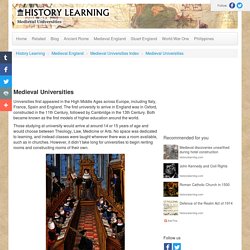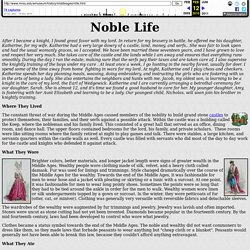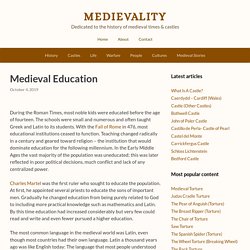

U5. High & Late Middle Ages. What was so special about Viking ships? - Jan Bill. The Vikings came from the sparsely populated outskirts of Northern Europe.

Through their seafaring skills, they were nevertheless able to have a tremendous impact on history. Why were they so exceptional seafarers? The Viking Age is a modern name for the period ca. AD 700-1066 in Northern Europe. The word “viking” was used already then to describe the act of travelling out on sea to plunder and gain riches, but could also be used to describe a person doing this. The Viking ships are known from a number of archaeological finds, mostly from Norway and Denmark.
Medieval and Middle Ages History Timelines - Education and Learning. Medieval Universities. There is evidence that teaching began in Oxford in the late 11th Century, but it wasn’t until a quarrel between Henry II and Thomas Becket in 1167 when the university grew.

During this time a temporary ban on English scholar studying in Paris meant higher learning was limited, so scholars turned to Oxford to continue their studies. From this moment on universities in England Scotland started to establish their reputations. Cambridge University was established in 1209, while the University of St Andrews was built between 1210 and 1213.
Pope Gregory VII also helped universities grow elsewhere in Europe, beginning with the issuing of a papal decree in 1079 that mandated that cathedral schools should be created to educate the clergy. This resulted in the spread of centres of learning around Europe, evolving quickly into Europe’s first medieval universities. See also: Medieval Students Medieval Education Medieval Studies Monastic Colleges Medieval Colleges at Oxford Medieval Colleges at Cambridge. Medieval University - Medievalists.net. The Medieval University was a system of higher education that emerged in western Europe during the late 11th and early 12th centuries.

The creation of the university is a matter of debate – how much were they based on the Cathedral and monastic schools of the Early Middle Ages? How much influence did Islamic and Roman classical models have on the development? Or were they unique institutions, the result of medieval teachers and students thinking ‘outside the box’ and figuring out a new way of learning? Whatever the reason, by the late 11th century groups of teachers and students started to get together in groups known as ‘universitas’ – in cities such as Salerno and Bologna in Italy, Paris in France and Oxford and Cambridge in England. The main curriculum was based on seven areas – grammar, rhetoric, logic, arithmetic, music, geometry, and astronomy – all of which were important for a cleric in the Catholic church.
See also: C3 Mathematics / Aprender a aprender. Noble Life. Organization: Alexa Crawls Starting in 1996, Alexa Internet has been donating their crawl data to the Internet Archive.

Flowing in every day, these data are added to the Wayback Machine after an embargo period. this data is currently not publicly accessible. Noble Life After I became a knight, I found great favor with my lord. Where They Lived The constant threat of war during the Middle Ages caused members of the nobility to build grand stone castles to protect themselves, their families, and their serfs against a possible attack. What They Wore Brighter colors, better materials, and longer jacket length were signs of greater wealth in the Middle Ages.
Facts, Information, Summary. During the Roman Times, most noble kids were educated before the age of fourteen.

The schools were small and numerous and often taught Greek and Latin to its students. With the Fall of Rome in 476, most educational institutions ceased to function. Teaching changed radically in a century and geared toward religion – the institution that would dominate education for the following millennium. In the Early Middle Ages the vast majority of the population was uneducated; this was later reflected in poor political decisions, much conflict and lack of any centralized power.
Charles Martel was the first ruler who sought to educate the population. The most common language in the medieval world was Latin, even though most countries had their own language. Those who studied in a monastery often became monks and worked by writing books and preserving Greek and Roman texts. Most peasants were never allowed to study as the fees required by the church were beyond their reach.